NVIDIA’s GeForce GTX 460: The $200 King
by Ryan Smith on July 11, 2010 11:54 PM EST- Posted in
- GPUs
- GeForce GTX 400
- GeForce GTX 460
- NVIDIA
Power, Temperature, & Noise
As we’ve discussed in previous articles, with the Fermi family GPUs no longer are binned for operation at a single voltage, rather they’re assigned whatever level of voltage is required for them to operate at the desired clockspeeds. As a result any two otherwise identical cards can have a different core voltage, which muddies the situation some. All of our GTX 460 cards have an idle voltage of 0.875v, while their load voltage is listed below.
| GeForce GTX 460 Load Voltage | |||||
| Ref 768MB | Ref 1GB | EVGA 768MB #1 | EVGA 768MB #2 | Asus 768MB | Zotac 1GB |
|
0.987v
|
1.025v
|
0.987v
|
1.000v
|
0.987v
|
1.000v
|
Our cards end up ranging from 0.975v to 1.025v, a variance of 0.05v. The 1GB cards with additional functional units on average require more voltage to operate, with the lowest of our samples requiring 1.0v. Otherwise 3 of our 4 768MB cards require 0.975v.
On a side note, since we’re using non-matching 1GB GTX 460s here for SLI testing, we’ve added an asterisk for all the power & temperature results. Our results should be very close to what a proper set of matching reference cards would get, but we can’t guarantee that.
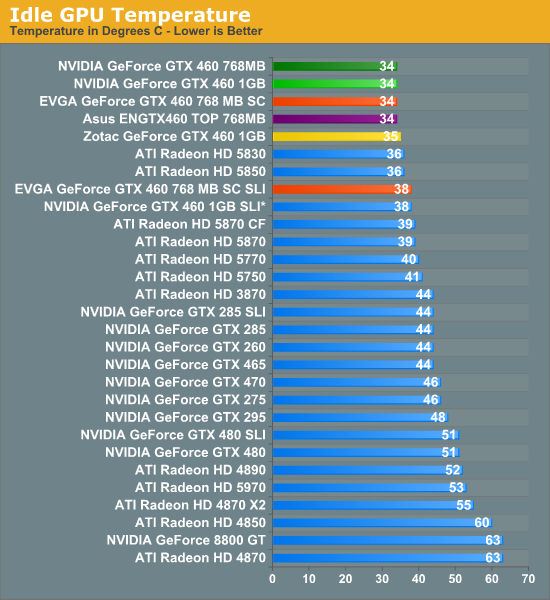
We’ll start with idle temperatures. With an unofficial idle TDP in the 20W range, the GTX 460 series is fairly comparable to the Radeon 5850, but with a more breezy cooler. As a consequence we can see it edge out the rest of our cards here, with all of the open GTX 460s coming in at 34C for idle. Meanwhile the blower-based Zotac card comes in a hair warmer at 35C. Even with a blower, these end up being the coolest mid-range or better cards we have ever tested, besting even the Radeon 5850.
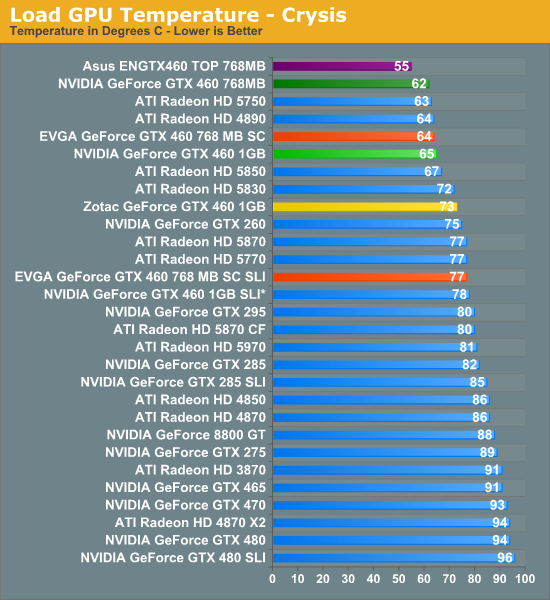
Meanwhile at load the good news continues for the GTX 460 series. The GTX 480 may have been a toasty GPU, but that’s not the case for the GF104 GPU at the heart of the GTX 460 series. Our reference cards do only slightly worse than 60C in Crysis, while Asus’s non-reference card gets that even lower thanks to a more proactive fan. Zotac’s blower doesn’t fare so well here though, coming in at a still respectable but nevertheless higher 73C.
Compared to AMD’s cards the GTX 460 does very well here. The Radeon 5850 is still the sweet spot for a balance of performance and heat, but the GTX 460 manages to do better in terms of heat at a price of lower gaming performance. Meanwhile our Radeon 5830 isn’t even a contender here; as a salvaged Cypress part, it just can’t compete with a part designed for cooler performance from the start. Among all the cards we’ve tested equal to or faster than the 8800GT however, the GTX 460 sets the new bar for how cool a high performance card can operate.

The results with Furmark match those of Crysis, it’s just a bit hotter. The interesting story here is going to be SLI temperatures: our 768MB and 1GB SLI cards hit 89C and 91C respectively. This isn’t a problem for NVIDIA’s GPUs (we see single GTX 480 cards do worse) but it’s a massive jump from a single card. For these reasons we would strongly suggest keeping these cards further spaced apart if you have a motherboard that supports it. The GTX 460 reference cooler just isn’t up to the task of pulling in fresh air if it’s next to another card.
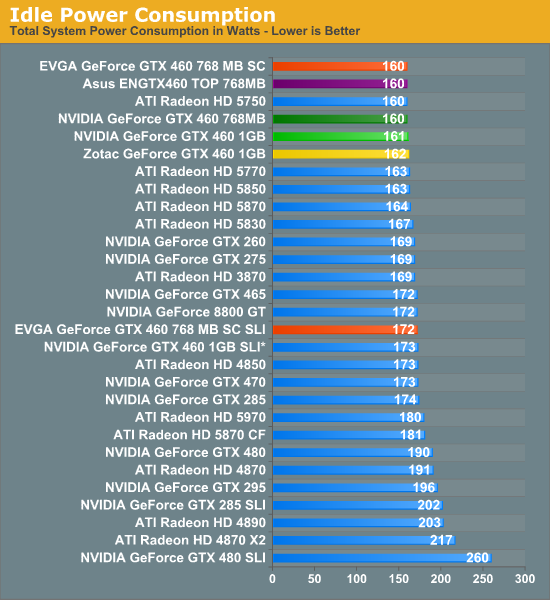
Our idle power numbers continue to lower the bar for GPUs of this performance class, although at this point we’re hitting the efficiency limits of our PSU at low wattages. Our 768MB GTX 460s end up sharing the 160W mark with the Radeon HD 5750, while for 1W more you have the 1GB cards.
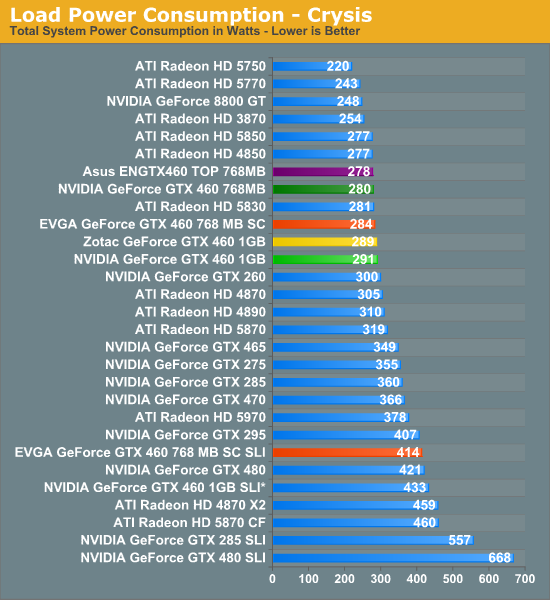
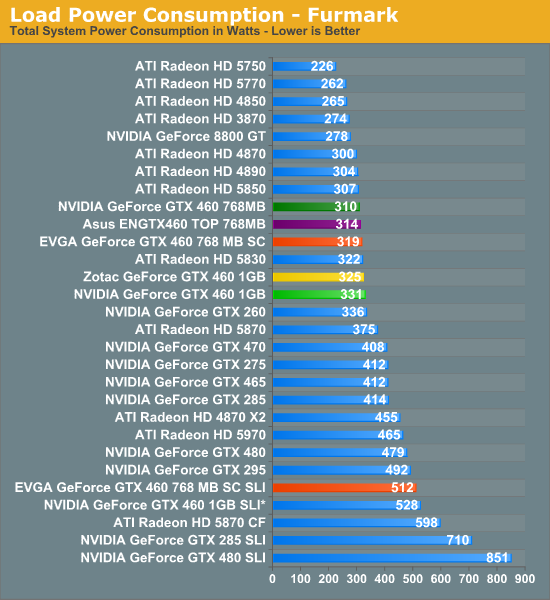
When looking at load power consumption, it’s always interesting to compare the power drawn with the temperatures. While the GTX 460 did very well here with regard to temperature, its power consumption reflects the fact that its GPU is still Cypress-sized. Under Crysis at a 280W load the 768MB part is comparable to the Radeon 5830 and the 1GB part adds around 10W to that. Meanwhile the Radeon 5850 manages to pull just a bit less power here, while the GTX 465 draws some 60W-70W more than the GTX 460. Gmae performance with those two cards may be close – power consumption is not.
As for Furmark the power consumption goes up but the ordering does not. Our 1GB cards now draw 20W more than 768MB cards, but the Radeon 5830 is still in the middle of the pack while the Radeon 5850 comes out ahead. The GTX 465 is now 80W-100W hotter than the GTX 460. Overall with a “proper” Radeon 5000 series card NVIDIA still can’t match AMD on a performance per watt basis, but they can come very close.
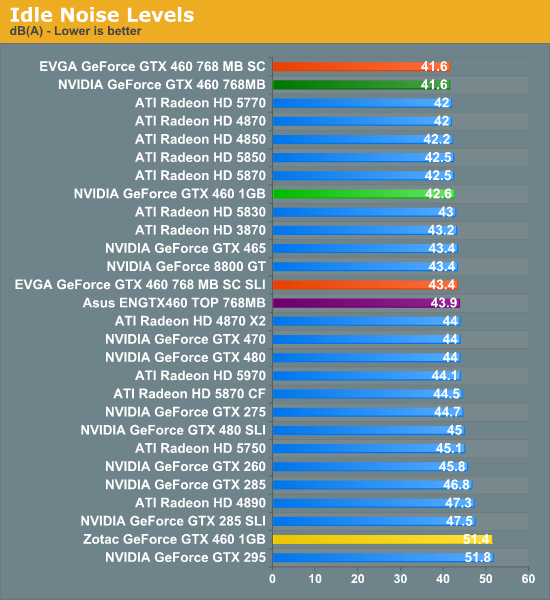
Finally we have our look at noise. With cool running cards we often have to look at fan noise to ensure that they aren’t accomplishing that trick by sounding like a jet engine, and in the case of the GTX 460 that’s clearly not the case. Besides being some of the coolest cards we’ve tested at this performance level the GTX 460 cards are also just as quiet as the rest of the best of the cards we’ve tested, hugging the 42dB sound floor in our testing environment. The 1GB reference card is marginally louder, while the partner customized cards are only slightly louder yet. The only card to really flop here is the Zotac GTX 460, which is at entirely the wrong end of our charts. Blowers can be quiet, but the Zotac’s is not – it’s simply a loud card. Unfortunately this kind of an idle noise level is going to put the card out of the running for a lot of buyers.
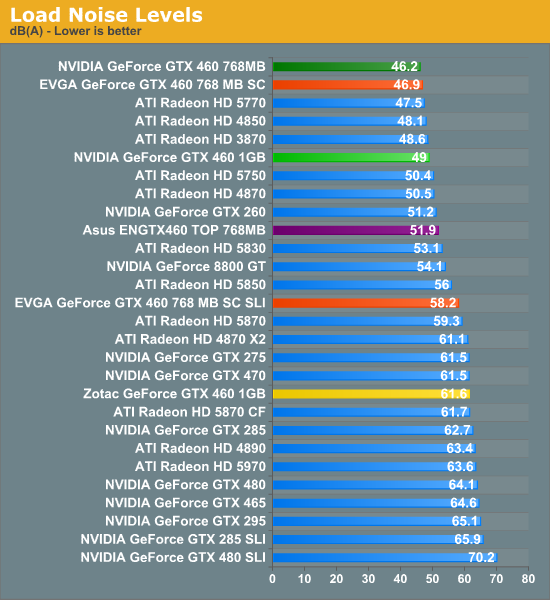
Load noise is more or less like our idle noise results. The 768MB GTX 460 registers the lowest result we’ve ever seen for a card of this performance level, coming in at 46.2dB and the EVGA card right behind it. The 1GB card does end up being louder (likely to compensate for cooling 2 more GDDR5 chips) but it’s still in good company. Asus’s card cracks 50dB, as it’s tuned for cooling over noise, explaining our earlier temperature results. Unfortunately the Zotac card is once again the odd man out at 61dB, roughly as loud as our GTX 470 is. It’s neither cooler than our reference cards nor quieter, which doesn’t bode well for this stock-clocked card.










93 Comments
View All Comments
Alroys - Monday, July 12, 2010 - link
Nice review, but i would have liked to see how well they overclock.beginner99 - Monday, July 12, 2010 - link
Not a bad card. I ordered a 5850 for my new build. 460 is a little less performing but more quite. The ordered 5850 is out of stock and no due date. However till the 460's arrive it will probably also be a few weeks...Need to wait on price. usually quite a bit higher here.KITH - Monday, July 12, 2010 - link
Quiet and Quite are different words...460 is a little less performing but more *quiet*
Usually *quite* a bit higher here.
See the difference? You even used both in your own post.
chizow - Monday, July 12, 2010 - link
Looks like a great part from Nvidia that seems to hit the same target price and performance markets as the wildly 8800GT before it. Much as the G92 and its derivatives dominated the gaming market while bringing DX10 to the mainstream, GTX 460 may be poised to do the same.Griswold - Monday, July 12, 2010 - link
Its not going to dominate anything but nvidias own lineup. AMD will just - finally - drop prices, and thats that.james.jwb - Monday, July 12, 2010 - link
I agree. AMD will either drop the price on the 5850 to make this new card redundant, or not do it and make a major mistake.chizow - Monday, July 12, 2010 - link
I doubt they're willing to drop the price on the 5850 enough to truly compete with the GTX 460, especially the 768MB version.. Maybe match the 1GB version's $230 price point by going to $250 but then what does that do to the 5870? Who's going to buy a 5870 at $400 when a 5850 only costs $250? Either way it looks like Nvidia has that $200-$250 market locked tight and in a few months with MIRs that'll shift to the $160-$220 range.Lonyo - Wednesday, July 14, 2010 - link
Considering the launch prices were $260/$380, there's no reason to imagine a drop to $250 would leave the 5870 at $400.Maybe we would see something like $250/$350. Finally a drop from launch prices.
papapapapapapapababy - Monday, July 12, 2010 - link
i mean why bother? to play ports like "singularity" with bump mapped ( and terrible low res textures?) i mean the pos3 game only uses about 140MB of my video ram! ati, nvidia, intel, amd, no real pc games? > no sale. adeus suckers!mindbomb - Monday, July 12, 2010 - link
What does the presence of hdmi v1.4 ports mean?Does this card have 3d bluray capabilities not seen on other cards?